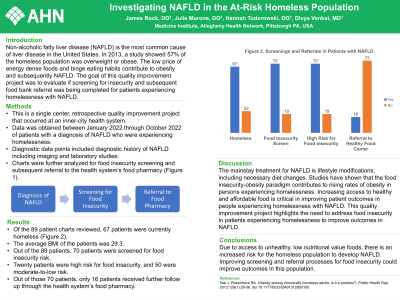Tuesday Poster Session
Category: Liver
P3814 - Investigating Non-Alcoholic Fatty Liver Disease in the At-Risk Homeless Population
Tuesday, October 24, 2023
10:30 AM - 4:00 PM PT
Location: Exhibit Hall

Has Audio
- JR
James Rock, DO
Allegheny Health Network
Pittsburgh, PA
Presenting Author(s)
James Rock, DO, Julie Murone, DO, Hannah Todorowski, DO, Divya Venkat, MD
Allegheny Health Network, Pittsburgh, PA
Introduction: Non-alcoholic fatty liver disease (NAFLD) is currently the most common cause of liver disease in the United States. It is currently estimated that 20-30% of all United States citizens have NAFLD. Based on a study in 2013 by Tsai et al., 57% of the homeless population across America were overweight or obese. The low price of energy dense foods, binge eating habits, and childhood poverty leading to obesity in adulthood all have impact on the homeless population becoming overweight or obese. The goal of this quality improvement project was to evaluate if healthy food screening and referral was being completed for patients experiencing homelessness with NAFLD.
Methods: This is a single center, retrospective quality improvement project that occurred at an inner-city health system. Between January 2022 through October 2022, a patient list was compiled of those who had a diagnosis of NAFLD and determined to be experiencing homelessness. Data points that were collected include diagnostic history of NAFLD, food insecurity screening, and follow up. We evaluated 89 patients who carried the diagnosis of NAFLD. We determined homelessness based on prior documentation. We reviewed each patient’s chart, their diagnostic history of NAFLD, imaging, laboratory studies, and if they have been screened for food insecurity. We reviewed if the patients received a healthy food center referral.
Results: Of the 89 patient charts reviewed, 67 patients were currently homeless. There were 24 females and 65 males. The average BMI of the patients was 29.3. Out of the 89 patients, 70 patients were screened for food insecurity risk. 20 patients were high risk for food insecurity, and 50 were moderate-to-low risk. Out of those 70 patients, only 16 patients received further follow up through the health system’s Healthy Food Center.
Discussion: One mainstay treatment for NAFLD is healthy lifestyle choices and lifestyle modifications. Studies have shown that the food insecurity-obesity paradigm is leading our homeless populations to becoming more obese. Increasing access to healthy and affordable food is critical in improving patient outcomes in homeless patients with NAFLD. This quality improvement project highlights the need to address food insecurity in patients experiencing homelessness to improve outcomes in NAFLD.
Disclosures:
James Rock, DO, Julie Murone, DO, Hannah Todorowski, DO, Divya Venkat, MD. P3814 - Investigating Non-Alcoholic Fatty Liver Disease in the At-Risk Homeless Population, ACG 2023 Annual Scientific Meeting Abstracts. Vancouver, BC, Canada: American College of Gastroenterology.
Allegheny Health Network, Pittsburgh, PA
Introduction: Non-alcoholic fatty liver disease (NAFLD) is currently the most common cause of liver disease in the United States. It is currently estimated that 20-30% of all United States citizens have NAFLD. Based on a study in 2013 by Tsai et al., 57% of the homeless population across America were overweight or obese. The low price of energy dense foods, binge eating habits, and childhood poverty leading to obesity in adulthood all have impact on the homeless population becoming overweight or obese. The goal of this quality improvement project was to evaluate if healthy food screening and referral was being completed for patients experiencing homelessness with NAFLD.
Methods: This is a single center, retrospective quality improvement project that occurred at an inner-city health system. Between January 2022 through October 2022, a patient list was compiled of those who had a diagnosis of NAFLD and determined to be experiencing homelessness. Data points that were collected include diagnostic history of NAFLD, food insecurity screening, and follow up. We evaluated 89 patients who carried the diagnosis of NAFLD. We determined homelessness based on prior documentation. We reviewed each patient’s chart, their diagnostic history of NAFLD, imaging, laboratory studies, and if they have been screened for food insecurity. We reviewed if the patients received a healthy food center referral.
Results: Of the 89 patient charts reviewed, 67 patients were currently homeless. There were 24 females and 65 males. The average BMI of the patients was 29.3. Out of the 89 patients, 70 patients were screened for food insecurity risk. 20 patients were high risk for food insecurity, and 50 were moderate-to-low risk. Out of those 70 patients, only 16 patients received further follow up through the health system’s Healthy Food Center.
Discussion: One mainstay treatment for NAFLD is healthy lifestyle choices and lifestyle modifications. Studies have shown that the food insecurity-obesity paradigm is leading our homeless populations to becoming more obese. Increasing access to healthy and affordable food is critical in improving patient outcomes in homeless patients with NAFLD. This quality improvement project highlights the need to address food insecurity in patients experiencing homelessness to improve outcomes in NAFLD.
Disclosures:
James Rock indicated no relevant financial relationships.
Julie Murone indicated no relevant financial relationships.
Hannah Todorowski indicated no relevant financial relationships.
Divya Venkat indicated no relevant financial relationships.
James Rock, DO, Julie Murone, DO, Hannah Todorowski, DO, Divya Venkat, MD. P3814 - Investigating Non-Alcoholic Fatty Liver Disease in the At-Risk Homeless Population, ACG 2023 Annual Scientific Meeting Abstracts. Vancouver, BC, Canada: American College of Gastroenterology.
